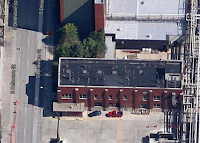This week, we take a look at how Agatha Christie used description of place to set the scene and reveal character in The Crooked House.
Chapter 2
I returned to England on a soft grey day in September. The leaves on the trees were golden in the evening light. There were playful gusts of wind.
Chapter 6
Sleuth describes Magda’s parlor.
Chapter 6
Sleuth describes Magda’s parlor.
We passed through it into a rather surprisingly spacious hall. It was furnished with restraint – well-polished dark oak and gleaming brass. At the back, where the staircase would normally appear, was a white paneled wall with a door in it. (…) We went through the doorway on the left into a large drawing room. It had pale-blue paneled walls, furniture covered in heavy brocade, and on every available table and on the walls were hung photographs and pictures of actors, dancers, and stage scenes and designs. A Degas of ballet dancers hung over the mantelpiece. There were masses of flowers, enormous brown chrysanthemums and great vases of carnations.
Sleuth describes the library.
It was a big room, full of books. The books did not confine themselves to the bookcases that reached up to the ceiling. They were on chairs and tables and even the floor. And yet there was no sense of disarray about them. The room was cold. There was some smell absent in it that I was conscious of having expected. It smelt of the mustiness of old books and just a little beeswax. In a second or two I realized what I missed. It was the scent of tobacco. Philip Leonides was not a smoker.
It was a big room, full of books. The books did not confine themselves to the bookcases that reached up to the ceiling. They were on chairs and tables and even the floor. And yet there was no sense of disarray about them. The room was cold. There was some smell absent in it that I was conscious of having expected. It smelt of the mustiness of old books and just a little beeswax. In a second or two I realized what I missed. It was the scent of tobacco. Philip Leonides was not a smoker.
Sleuth describes Clemency’s apartment.
The walls were painted white – really white, not an ivory or a pale cream which is what one usually means when one says “white” in house decoration. They had no pictures on them except one over the mantelpiece, a geometrical fantasia in triangles of dark grey and battleship blue. There was hardly any furniture – only mere utilitarian necessities, three or four chairs, a glass-topped table, one small bookshelf. There were no ornaments. There as light and space and air. It was as different from the big brocaded and flowered drawing room on the floor below as chalk from cheese.
The bedroom with its twin beds and white coverlets and its simplified toilet appliances reminded me again of a hospital or some monastic cell. The bathroom, too, was severely plain with no special luxury fitting and no array of cosmetics. The kitchen was bare, spotlessly clean, and well equipped with labour-saving devices of a practical kind.
The bedroom with its twin beds and white coverlets and its simplified toilet appliances reminded me again of a hospital or some monastic cell. The bathroom, too, was severely plain with no special luxury fitting and no array of cosmetics. The kitchen was bare, spotlessly clean, and well equipped with labour-saving devices of a practical kind.
Then we came to a door which Clemency opened, saying: “This is my husband’s special room.” This was an intensely personal room. There was a large roll-top desk untidily covered with papers, old pipes, and tobacco ash. There were big shabby easy-chairs. Persian rugs covered the floor. On the walls were groups, their photography somewhat faded. School groups, cricket groups, military groups. Water-color sketches of deserts and minarets, and of sailing-boats and sea effects and sunsets. It was, somehow, a pleasant room, the room of a lovable, friendly, companionable man.
Sleuth describes Brenda's parlor.
Its proportions were the same as the drawing room on the ground floor below. There were colored cretonnes, very gay in color, and striped silk curtains. Over the mantelpiece was a portrait that held my gaze riveted – not only because of the hand that painted it, but also because of the arresting face of the subject.
Chapter 14
Sleuth describes the drawing room.
Its proportions were the same as the drawing room on the ground floor below. There were colored cretonnes, very gay in color, and striped silk curtains. Over the mantelpiece was a portrait that held my gaze riveted – not only because of the hand that painted it, but also because of the arresting face of the subject.
Chapter 14
Sleuth describes the drawing room.
It was a woman’s room, exotic, soft, shut away from the rude blasts of outside weather. It was not a room that a man would be happy in for long. It was not a room where you could relax and read the newspaper and smoke a pipe and put up your feet. Nevertheless, I preferred it to Clemency’s own abstract expression of herself upstairs. On the whole I prefer a boudoir to an operating theatre.
***
Christie's amateur sleuth in The Crooked House commented on the rooms as he discovered them. There was very little description of place from chapters 15 through 26. Only as much as was needed to place a character in a chair, etc.
Christie's method was spare and to the point. She used the different living spaces to reveal character. This is a technique you can use in your story. What do your characters' personal spaces say about them?
Next week, we'll look at the planting and payoff of clues in The Crooked House.



